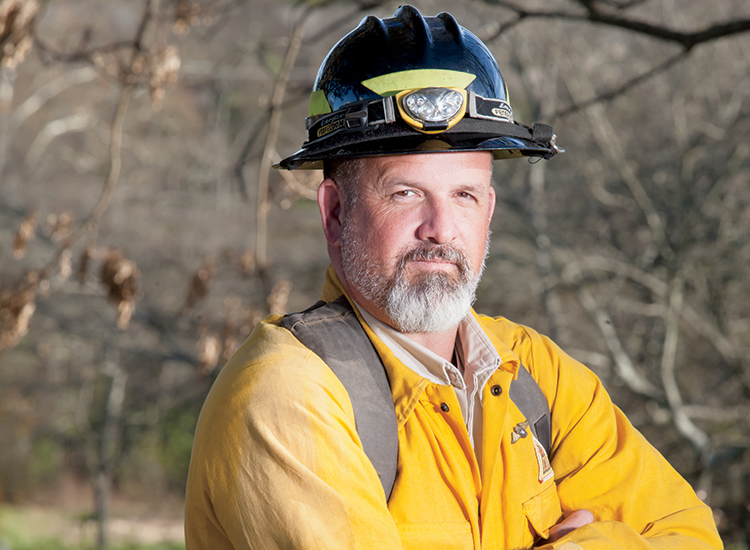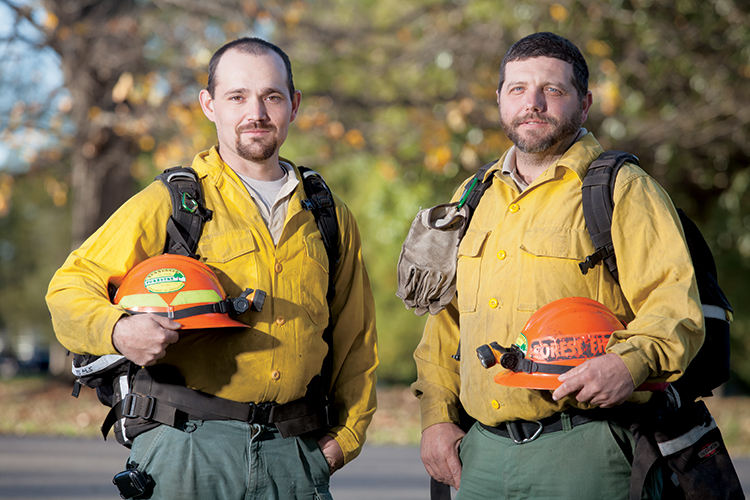Home > Tennessee > Tennessee Environment > Fired Up: State Firefighters Protect Tennessee’s Forests
Fired Up: State Firefighters Protect Tennessee’s Forests
In partnership with: Tennessee Department of Agriculture

Nearly half of Tennessee is covered with forests. This beautiful land provides recreation, serves as wildlife habitat, allows for timber production and enhances the overall environment. But tens of thousands of the state’s 14 million acres of forest are at risk every year because of wildfires.
The Tennessee Department of Agriculture Division of Forestry is responsible for protecting the state’s forestlands. Their 200 full-time and 150 part-time firefighters provide the front line of that protection.
Weather and terrain make it a challenging and often unpredictable task, but the firefighters have the training and resources to tackle it proactively while keeping safety their top priority.
“While we fight fires year round, we have two primary seasons,” says John Kirksey, the division’s Fire Management Unit leader. “The fall season is from mid-October until the end of November, and the spring season is from about March 1 until the middle of May. The threat is higher during those times because of dry weather, and because it’s a time when people are burning more debris.”
![Tn firefighters [INFOGRAPHIC]](https://eadn-wc01-4177395.nxedge.io/wp-content/uploads/2020/08/Screen-Shot-2016-03-10-at-12.35.29-PM.jpg)
That burning is responsible for a large percentage of Tennessee’s forest fires. The Division of Forestry works to lower the threat through education, prevention and burn permit regulation.
Brock Campbell, a forestry technician for the division, explains that the state requires landowners and the public to obtain a permit before burning any debris in the open air. The requirements serve two purposes: they provide an opportunity for the public to be educated about safe debris burning, and they let the division know where fires will be burning, so they can be alert for any problems.
“During the fire season, we issue nearly 100 permits a day in Greene, Washington and Unicoi counties,” he says. “With each one given, we provide a safety checklist. Following those tips and taking adequate precautions can be the difference between a safe debris burn and one that quickly gets out of control.”
When there is a forest fire, whether from unsafe burning, arson, lightning or other causes, the division and firefighters are ready. Much of the work involves coordination of the many aspects of firefighting – from aerial detection and crew dispatch to assembling the equipment to dig a containment line around the fire.
“In active firefighting there are many different roles,” Kirksey says. “There are those out there containing the fire line and those who support their efforts in terms of logistics and management. We have folks who might not have stepped foot near a wildfire this year, but they were actively involved in training, equipment and preparedness work in addition to fire prevention.”

Taking the Heat
There are an average of 2,000 wildfires each year in the state that burn about 25,000 acres. That’s a lot of digging, a lot of heat and a lot of experience fighting Tennessee fires. And in the summer when wildfires are less likely to burn in the Volunteer State, many of Tennessee’s forest firefighters help out in the West, where the size and intensity of the fires require more manpower.
Campbell spent 24 days in California in the summer of 2015 on fire detail. He was one of nearly three dozen Tennessee firefighters to head west to help on larger fires.
“It’s an opportunity to help, and it also provides our firefighters with a very challenging experience that better prepares us for our work in Tennessee,” Campbell says.
He explains that the higher elevations, extremely dry fields and rugged terrain create conditions unlike those seen in Tennessee. “Plus, the fires themselves are explosive. They burn hotter and faster, and they’re usually much larger.”
Kirksey says every opportunity to work a fire – whether here or on a western detail – provides firefighters with a chance “to improve their situational awareness.”
“There are so many hazards in addition to the fire itself that you need to always be aware of, like holes that are covered by leaves and moving rocks. Situational awareness is the key to safety.”
Keeping firefighters and the public safe is the Division of Forestry’s top priority.
![Tn firefighters [INFOGRAPHIC]](https://eadn-wc01-4177395.nxedge.io/wp-content/uploads/2020/08/Screen-Shot-2016-03-10-at-12.35.20-PM.jpg)



